| Web Smart Gigabit Switch Family User's Guide |
|
|
transmit the frames from the MAC address list in the port’s static MAC address table.
4.2.2 Port Statistic and Port Status
Port Statistic calculates the statistics of each port, such as how many frames, error frames, broadcast frames it has received, and so on.
Port Status indicates whether the port is linkup, linkdown or disabled, what speed and duplex mode it is working on, and whether flow control is enabled or disabled.
4.2.3 Storm Control
Storm control limits the amount of multicast, broadcast and UL (addresses that have not been learned) frames accepted and forwarded by the device. When Layer 2 frames are forwarded, broadcast, multicast and UL frames are flooded to all ports on the relevant VLAN. This occupies bandwidth, and loads all nodes on all ports.
A Storm is a result of an excessive amount of these frames simultaneously transmitted across a network by a single port. Forwarded message responses are heaped onto the network, straining network resources or causing the network to time out. Storm control is enabled for all ports by defining the packet type and the rate at which the packets are transmitted. The system measures the incoming defined frame rates on each port, and discards the frames when the rate exceeds a
4.2.4 Port Description
Use a description word to indicate the port.
13
